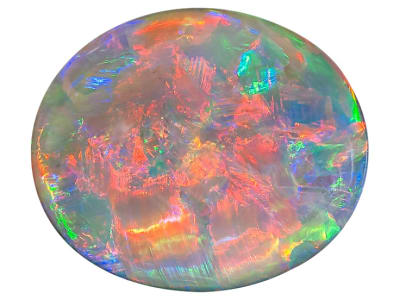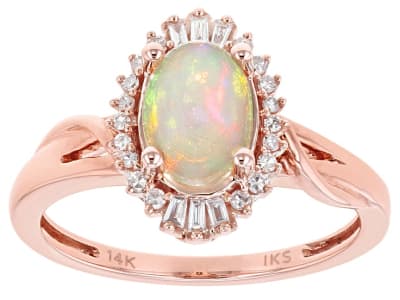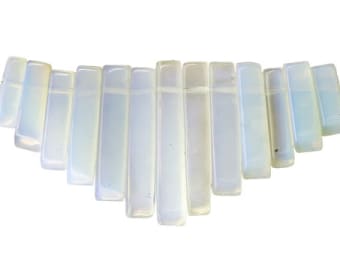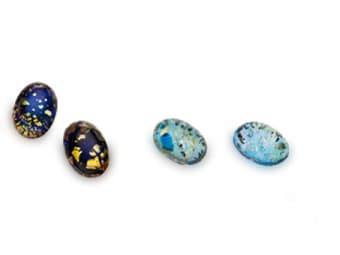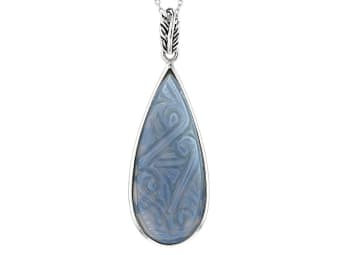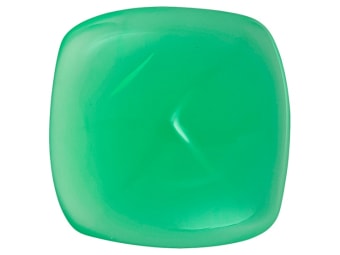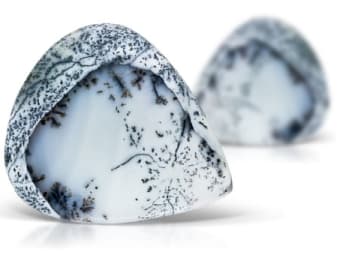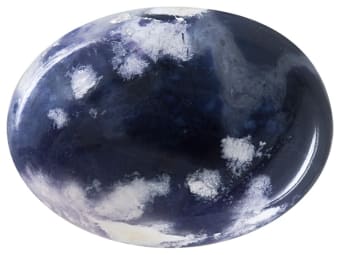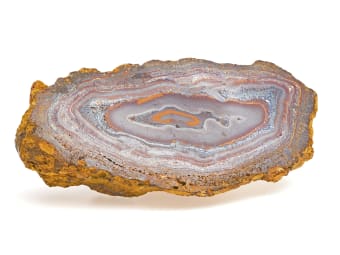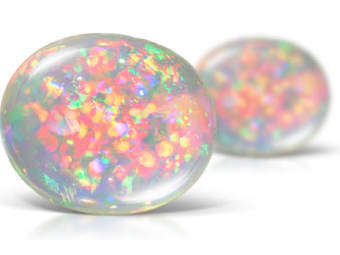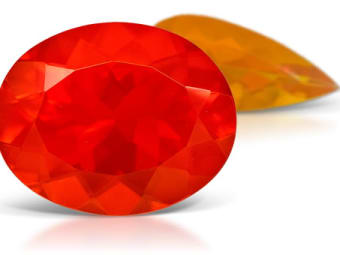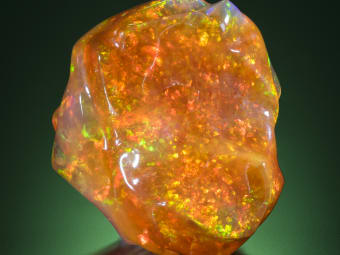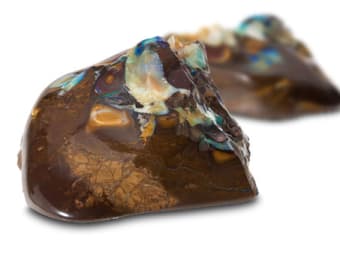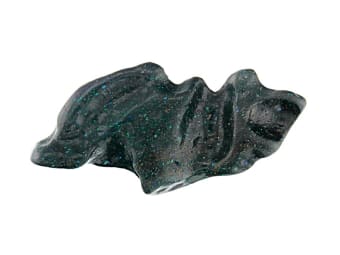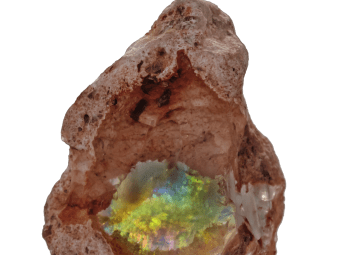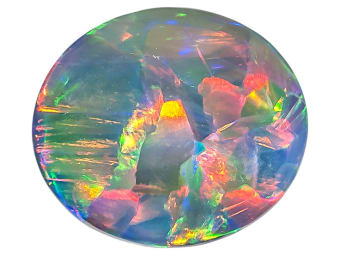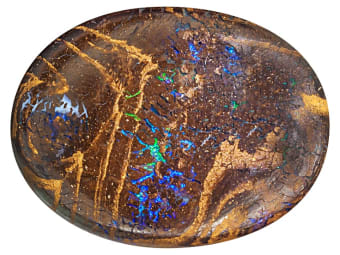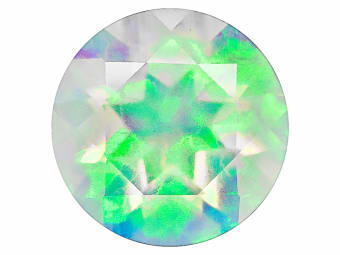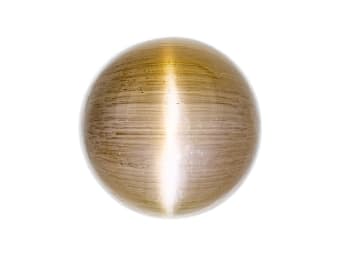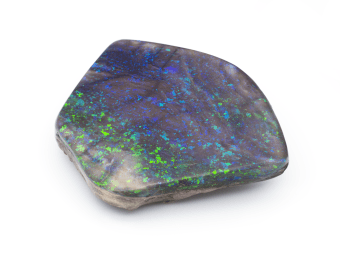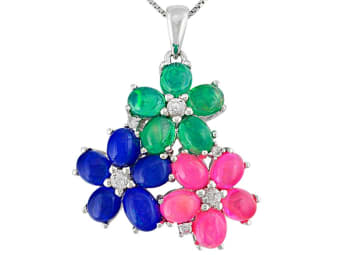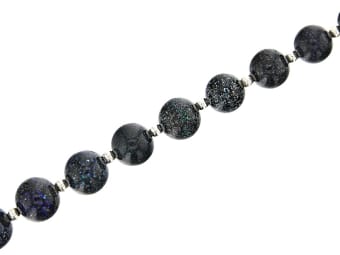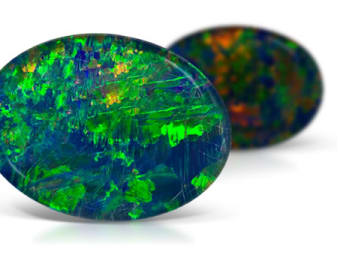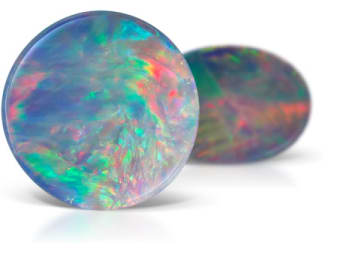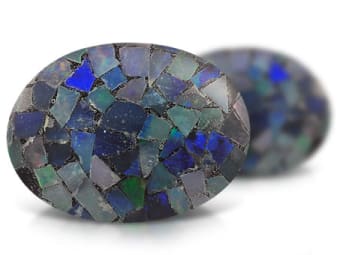The name opal comes from the Latin word opalus and is derived from the Sanskrit word upala which means precious stone. Opals were first mined from Červenica, also known as Czernowitza, the mountainous region of Slovakia two thousand years ago. Opals gained widespread popularity after it was discovered in 1869 in Australia. Opal has no crystal structure, and it is an amorphous form of hydrated silica. It comes in two forms, precious opal that displays the play-of-color phenomena, and common opal that does not.
General Information
LWUV: inert to strong green or yellowish green
Opal Colors
-
 Black
Black -
 Blue
Blue -
 Blue
Blue -
 Brown
Brown -
 Gray
Gray -
 Green
Green -
 Green
Green -
 Multi-color
Multi-color -
 Multi-color
Multi-color -
 Orange
Orange -
 Pink
Pink -
 Purple
Purple -
 Red
Red -
 White
White -
 White
White -
 Yellow
Yellow
Opal Spectra
We acknowledge the significant scientific contributions of John S Harris, FGA to the study of gemstone spectra and with deep appreciation to him, acknowledges the use of his images and related notes about gemstones and their spectra in the educational materials on this website.
Alternate Names
Potch, Opal Without Play-Of-Color, Common Opal, Colored Opal, Precious Opal, Opal With Play-Of-Color, Gilson Opal
Countries of Origin
Myanmar; Cameroon; Papua New Guinea; Angola; Cambodia; Malaysia; Kazakhstan; Paraguay; Portugal; Iceland; Oman; Greece; Austria; Mongolia; Korea (the Republic of); Morocco; Unknown; Mali; Marshall Islands; Panama; Brazil; Algeria; Chile; Colombia; Ecuador; Argentina; Hungary; Republic of Kosovo; Japan; Ukraine; Bolivia (Plurinational State of); India; New Zealand; Canada; Vanuatu; Turkey; Belgium; Namibia; Finland; Honduras; Italy; South Africa; Antarctica; Georgia; Peru; Venezuela (Bolivarian Republic of); Ethiopia; Germany; Tanzania, United Republic Of; Afghanistan; Russian Federation; Fiji; Viet Nam; Czechia; United States of America; Egypt; Somalia; Madagascar; Thailand; United Kingdom of Great Britain and Northern Ireland; Libya; Costa Rica; Saudi Arabia; Sweden; Pakistan; China; Poland; Slovakia; Bulgaria; France; Jordan; Lithuania; Serbia; Romania; Togo; Sri Lanka; Rwanda; Uzbekistan; Kenya; Switzerland; Spain; Cuba; Mauritania; Saint Lucia; Norway; Denmark; Mexico; Zimbabwe; Israel; Australia; Greenland; Indonesia
History
Pliny the Elder wrote about the Indian opal mines in his Natural History of the World in 77AD. Pliny used the term opalus which translates to “precious stone”. The first true opals were found in what is now Czechia, northern Hungary, the Slovak Republic, Romania, and Poland. A mining license was issued in 1597 to the opal mines in Dubník in eastern Slovakia. In the New World Bernardino de Sahagún reported that the Aztecs mined opal in the mid-16th century in his General History of the Things of New Spain. In the Nahuatl language opal was known as vitziziltecpatl which translates to “hummingbird stone”. In 1849 the German geologist Johannes Menge discovered the first Australian Opal near Angaston, South Australia about 43 miles outside Adelaide. In 1869 opal was found at Listowel Downs Station in Queensland. The Hayricks mine outside Quilpie was the only Queensland opal producer between 1900 to 1957. When demand increased in the early to mid-1970’s opal production increased in the Queensland area until the late 1980’s. Opal was found at White Cliffs, New South Wales in 1889. In 1901 opal was discovered at Lightning Ridge, NSW and Black opal was discovered at the site in 1902. Opal was found in Coober Pedy 1915. In 1930 opal was found in Andamooka, South Australia. Opal was first found at Mintabie in 1920, and commercial mining started 1978 the same year Black opal was found in the area. Opal was found at Lambina Opal field in 1930. Ethiopian opals from Yita Ridge in the Shewa Province, Ethiopia were first introduced to the gemstone market in 1993. In 2008 white, orange to brown, and facetable crystal opals were found near Wegal Tena in the Wollo Province. Black opals were found in the Wollo Province in 2013.
Care
Avoid heat, solvents, chemicals, ultrasonic, and repolishing. Be mindful of scratching. Ethiopian opal avoid steamers or ultrasonics; keep away from harsh cleaning agents or perfume; simply clean with a soft cloth. Keep away from any fluids or oils, as they can be absorbed and alter appearance and or crack the stone. Avoid all types of heat. Color may fade with extended exposure to sunlight.
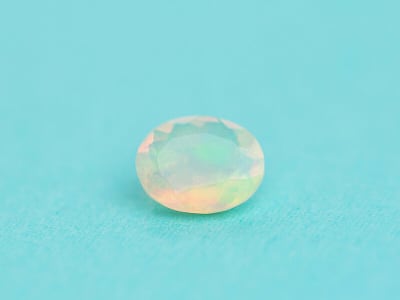
More About Opal
Sales of opal declined after the 1829 publication of Sir Walter Scott’s 3-volume novel Anne of Geierstein after the public began to associate the stone with bad luck. In the first volume of the series Lady Hermione vanishes after holy water is poured over the opal that adorned her hair.
Simulants
Plastic Opal Simulant
Some gems, like opal, are highly coveted, but rare to find, much less in the sizes and quality people dream of owning. Plastic opal simulants offer a budget friendly alternative to natural opal.
LWUV: Strong chalky white
Glass Opal Simulant
Some gems, like opal, are highly coveted but rare to find, much less in the sizes and quality people dream of owning. Glass opal simulants offer you the best of both worlds. You get the beauty of a beautiful natural opal, but at a budget-friendly price. This glass simulant recreates the beautiful play-of-color coveted in natural opal.
LWUV: Variable
Species/Variety
Blue Opal
The best-known locations of blue opal come from Peru, Madagascar, Oregon, Arizona and Indonesia. The material ranges from semitranslucent to opaque. Only 10% of the material from Arizona show play-of-color. The Peruvian and Indonesian material gets its color from copper inclusions. The Oregon material gets its color from an optical phenomenon known as Rayleigh scattering.
Prase Opal
Prase Opal is the yellowish to bluish green variety of common opal. The material obtains its color from Nickel. It is most often found in Kosovo, Iyobo Mountain mine in Tanzania and in California in the United States.
Green Opal
Green opal is the variety of green common opal that derives its color from iron. It is different from Prase opal that gets its color from Nickel. Green opal comes from Australia, Madagascar, Mali, Peru, Serbia and South Africa.
Mali Opal
Mali opal was first discovered in 2007 but it was not seen in the gemstone market until 2011. The stones get their color from iron. These opals were formed long ago near the Saharan desert, which was once the site of ancient seas. Production of rough material is very low. Only 50 carats of gemstones will be faceted from every 100 grams of rough material.
Hyalite Opal
Hyalite opal is known to come from Australia, Brazil, Mexico, Russia, South Africa and the U.S. It is named from the Greek word meaning ‘glass stone’ due to its glass-like appearance. It is colorless and does not display play-of-color and commonly forms as botryoidal aggregates.
Pink Opal
Pink opal is found in Peru and Mexico. It is translucent to opaque and comes in brownish pink to pure pink. Pink opal is a combination of opal grains in chalcedony and cristobalite. The chalcedony makes the material slightly more durable and it typically has a Mohs hardness of 5-5.5 but can be up to 6. Peruvian pink opal is colored by manganese. Recent reports attribute the color of pink opal to Palygorskite inclusions and some organic materials.
Dendritic Opal
Dendritic opals have fern-like dendritic crystalline inclusions. The stones are an intergrowth of opal and quartz. Black dendritic inclusions are due to manganese oxide crystallization.
Caramel Spice Opal™
Caramel Spice Opal™ is reported to come from Ojuelos de Jalisco, Mexico. It is easily distinguished by its rare, unique swirling patterns of brown, tan and white hues. Skilled cutters must carefully study each piece of rough before cutting to determine how to best display its swirl patterns. It has a mohs hardness of 6.
Morado Opal®
Morado Opal® is named from the Spanish word for “purple”. The material comes from a remote mining region located along the famous El Camino Real de Tierra Adentro National Historic Trail. The stones get their purple color from fluorite inclusions and are mottled with patches of white. Due to the intergrowth with quartz the stones have a Mohs hardness of 6.
Yowah Nut
Yowah Nut is a variety of Boulder Opal that derives its name from a locality in the Australian Outback. The nodules are about walnut size and will have colorful veins running throughout.
Ethiopian Opal
Opal with play of color has always been considered one of the most desired gems in the marketplace, earning it the undisputed title as 'Queen of Gemstones'. With the discovery of precious (and stable) opal in Ethiopia's northern Welo District in 2008, coupled with its prolific bounty, this remarkable gem has reclaimed its throne and rules again as one of the most in-demand gemstones in the 21st century.
Tolerance:-0.25
LWUV: Variable
Fire Opal
Fire Opal is a variety of transparent to translucent red, orange to brown or yellow opal. It typically does not display play-of-color phenomena but occasionally fine examples with play-of-color will occur. Fire opal is best known from North, Central and South American but it has multiple sources around the world.
Girasol Opal
The term girasol opal applies to Fire Opal that displays play-of-color.
Boulder Opal
Boulder Opal, also known as Queensland Opal, comes from Queensland, Australia. The material contains precious opal in an ironstone or sandstone matrix.
Leopard Opal
Leopard Opal is precious opal with play-of-color sprinkled throughout Vesicular Basalt rock. The colorful opal is striking against the black stone matrix. It is only found in Zimapán, Hidalgo State, Mexico.
Honduran Opal
Honduran Opal is precious opal embedded in grayish or black basalt matrix. Due to the porous structure of the matrix, finished gemstones are often given a quick, hot resin bath and then scrubbed and cleaned. The resin acts as a barrier and helps to prevent the gems from absorbing other substances.
Contra Luz Opal
Contra Luz Opal will show play-of-color when light from behind. Specimens come from Queretaro, Mexico and Opal Butte, Oregon in the United States of America.
Black Opal
Black Opal was discovered in 1902 and is the rarest and most valuable variety of opal. Any opal material that displays play-of-color against a dark body tone can be described as Black Opal. Lightning Ridge in Australia is the best-known location, but it is also known to come from Mintabie, Australia, Java, Virgin Valley, Nevada and Wollo, Ethiopia.
Matrix Opal
Opal in matrix gems consist of precious opal, often cut en cabochon, with an outer layer of its host rock still attached. This stark contrast of glittering translucent opal with earthy rock makes for beautiful, one-of-a-kind pieces.
LWUV: Variable
Creation Classification
Lab Created
Some gems, like opal, are highly coveted but rare to find, much less in the sizes and quality people dream of owning. Synthetic, or laboratory created jewels, offer you the best of both worlds. You get the beauty of a beloved, rare gemstone, but at a budget friendly price. The term synthetic refers to a man-made material with a natural counterpart. The synthetic crystal replicates the chemical, optical and physical properties of the natural crystal with little or no variation.
LWUV: Variable
Optical Phenomena
Cat's Eye Opal
Enhancement
Sugar Treated Opal
Sugar-acid treated opal has been submerged in heated sugar or honey solution for several hours to a couple of days. The opal is then submerged in sulfuric acid. The sugar becomes oxidized by the acid and creates carbon particles in the stone.
Smoke Treated Opal
Smoked treated stones are wrapped in aluminum foil and then exposed to smoke. The carbon from the smoke will permeate the stone and give a black or brown body color.
Dyed Ethiopian Opal
The hydrophane nature of Ethiopian opal allows the material take on dye. This property allows man to create vibrant red, blue, purple, pink or green opals.
Andamooka Matrix
Andamooka Matrix Opal is material from Andamooka, Australia that has been sugar or acid treated. Before treatment the material shows little play-of-color.
Material Composition
Opal Triplet
Opal triplets combine natural opal with layers of other materials. A thin slice of natural opal is assembled between a base (usually of matrix, plastic, glass or other material) and a colorless top that protects the natural opal. On occasion, the bonding agent may account for the third layer. Opal triplets typically provide a more affordable alternative to natural, solid opal.
Opal Doublet
An opal doublet is an assembled gem that consists of a thin slice of natural opal attached to a second layer of material with a bonding agent. The types of materials used for opal doublets vary considerably but may include ironstone, sandstone, black plastic or quartz. Opal doublets often provide a more affordable alternative to solid opals and are often used today for mass-produced jewelry.
Tolerance:-0.25
Mosaic Opal Triplet
As an affordable alternative to larger sized solid opals, mosaic opal triplets provide an affordable, and stylish, substitute. They are created by assembling a montage of small, thin opal slices and adhering them to a solid base material, which may be natural or man-made. The base material, often dark in color, provides a dramatic backdrop to the overall appearance of the triplet.
